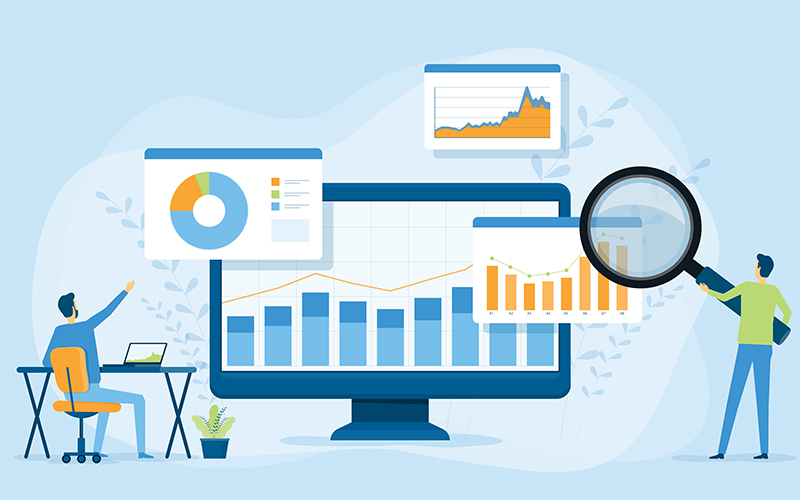BPM Analytics
The significance of customer analytics for businesses
Successful businesses throughout history have realised the importance of knowing and understanding their customers. Organised market research can provide them with insights into their target audience and assess the market viability of goods and services. Modern businesses are highly data centric and collect useful customer data at every interaction. With customer analytics, you can examine this information to better understand your customers and identify what influences their buying decisions.
Customer analytics is the structured examination of customers’ behaviour to glean insights into market trends. Customer analytics aims to recognise and predict customers’ needs by understanding their buying decisions from past interactions and transactions and adapting the business to meet evolving requirements and alleviate pain points. Simply put, it is the study of customers’ past to help an organisation serve them better in the future. Customer analysis marketing is crucial to any leading business’ overall marketing strategy.* Employing customer analytics can enhance how your organisation interacts with its customers in several ways, including:
- Speaking the customer’s language when outlining communications and marketing materials that directly address their objectives
- Creating marketing campaigns that target specific demographics
- Understanding which marketing channels work best for your intended audience and investing in them accordingly
- Improving products and services based on customer reviews
- Building long-lasting customer relationships and enhancing customer loyalty
Customer retention:
Customer engagement:
Knowing your clientele makes it possible to create customised experiences that align with their buying habits. Crafting such tailor-made experiences requires in-depth knowledge of customer behaviour and their immediate needs. Staying aware of the difficulties and frustrations they experience equips an organisation with the tools to improve the experience and appropriately engage with customers.
Boost sales and profits:
Identifying and tracking key customer analytics metrics enable businesses to recognise high-value customers and engage with them to bolster relationships through special offers or upsell relevant products and services. Knowing where your profitable customers are, understanding their needs, and focusing your marketing activities on those customers are sure-fire ways to boost revenue.
Validate expenses:
Business decisions based on data-driven insights are hard to fault. If detailed customer data analyses indicate the need to invest in a marketing activity or upgrade a certain customer-facing process, you have the evidence to justify and validate the expenses associated with these actions.
Let’s take a closer look at the core benefits of scrutinising and acting on customer experience data analytics.
It costs less for businesses to satisfy existing customers than to acquire new ones. If your organisation is facing high customer attrition rates, customer analysis can help highlight common factors that were responsible for customer loss. With this data, you can undertake corrective measures.
A systemised approach to collecting, categorising, managing, and analysing customer data helps draw accurate and actionable conclusions to add business value. The steps to executing a successful customer analytics project are as follows:
- Segment your existing customers based on geographic location, age, socio-economic status, the media they consume, and how they interact with your products or services.
- Know your customers better by conducting surveys, customer interviews, and focus group discussions.
- Analyse the existing feedback provided when customers are happy with a product or a service, need help, or wish to make a complaint. Such feedback helps understand customer issues and objectives.
- Collaborate to make the most of customer knowledge. Various teams gain different insights from their interactions with customers, and clear communication within the organisation is important to compile these insights into usable, structured data.
- Leverage analytics for accurate insights into customer behaviour, buying habits, client profitability, and more.
- Collate all the available data into buyer personas to clearly understand current and prospective customers and help identify your ideal customer.
- Collaborate and share customer analysis results and buyer personas across your organisation. Customer support, marketing, product, and sales teams can benefit from detailed customer research results and incorporate the findings into their processes.
- Decide which customer segments and buyer personas are immediate priorities and start working on them.
How can Infosys BPM help?
Thorough and effective customer analytics can greatly impact your business, and getting it right means collaborating with an experienced data analytics partner. Infosys BPM offers a slew of Marketing and Customer Analytics Services that include solutions for tracking and analysing consumer data. Reach out to know more about how your organisation can benefit from leveraging customer data.
*For organisations on the digital transformation journey, agility is key in responding to a rapidly changing technology and business landscape. Now more than ever, it is crucial to deliver and exceed organisational expectations with a robust digital mindset backed by innovation. Enabling businesses to sense, learn, respond, and evolve like living organisms, will be imperative for business excellence. A comprehensive yet modular suite of services is doing precisely that. Equipping organisations with intuitive decision-making automatically at scale, actionable insights based on real-time solutions, anytime/anywhere experience, and in-depth data visibility across functions leading to hyper-productivity, Live Enterprise is building connected organisations that are innovating collaboratively for the future.






